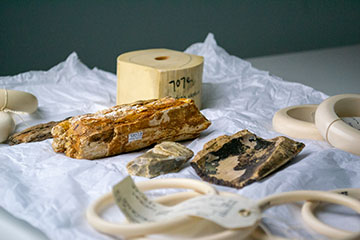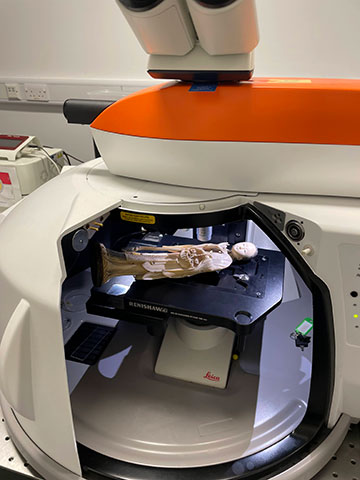
A selection of elephant and mammoth tusk samples. [Image: Ben Booth]
The Convention on International Trade in Endangered Species banned the international trade of ivory in 1990, but a market for illegal ivory persists today. Elephant poaching associated with the ivory trade is estimated to cause an 8 percent loss in the world’s elephant population every year, and elephant species are currently considered endangered to critically endangered.
Complicating law-enforcement efforts is the fact that the sale and trade of ivory from mammoths―an extinct species―is legal. Although mammoth and elephant tusks look quite different when whole, distinguishing between them after a tusk has been broken down into smaller parts or carved is difficult. Existing methods for assessing the legality of ivory, like DNA/mtDNA and isotope analysis, haven’t been practical for customs teams to implement because they are expensive, time-consuming and destructive.
Now, researchers from the Universities of Bristol and Lancaster, UK, have shown that Raman spectroscopy can be used to identify different types of ivory (PLoS One, doi: 10.1371/journal.pone.0299689). They say that the method could provide a quick, accurate and nondestructive way to discern between legal and illegal ivory—which they hope will ultimately enable better law enforcement and act as a deterrent for poachers.
Elephant or mammoth?
The well-established technique of Raman spectroscopy is already used in the analysis of bones and minerals. Since bone and ivory have similar biochemical properties, Rebecca Shepherd, University of Bristol, and her colleagues set out to test whether they could use the technique to detect the subtle chemical differences between mammoth and elephant tusks and thereby distinguish between ivory from the two species.

Raman spectroscopy can distinguish between mammoth and elephant ivory, potentially offering a fast, affordable and non-invasive method for identifying legal versus illegal ivory. [Image: Rebecca Shepherd]
For their study, the team procured eight samples of mammoth, two samples of African elephant and one sample of Asian elephant ivory from London’s Natural History Museum, all of which were well-preserved. The researchers scanned the ivory with an inVia Raman micro spectrometer equipped with a 50× objective lens and a 785 nm laser, 200 mW at source with 1200 l/mm grating. They documented 272 spectra from the mammoth samples, 203 spectra from the African elephant samples and 17 spectra from the Asian elephant sample.
Using the statistical method of principal component analysis, they were able to identify differences in the average spectra between species. Specifically, a statistically significant difference was detected when looking at the peak intensity ratios of phosphate to amide I and III peaks and carbonate to phosphate peaks—meaning that analysis of the data could potentially allow researchers to characterize the samples and figure out which species they came from.
Furthermore, the team found that its analysis was able to pick up on the advanced age of the mammoth ivory by demonstrating higher crystal maturity with full width at half maximum height analysis of the phosphate peak compared to living elephant species.
Preventing poaching
The authors acknowledge that the small number of samples analyzed in their study is a significant limitation and further work is needed to strengthen their findings. However, at this stage they believe that the results establish the potential of Raman spectroscopy as a fast, affordable and nondestructive method for identifying the species of unidentified ivory. They also note that, while they used a large, lab-based Raman spectrometer, another recent study indicated that smaller, handheld Raman spectrometers could offer a similar quality of data with the advantage of portability.
“Raman spectroscopy can provide results quickly (a single scan takes only a few minutes), and is easier to use than current methods, making it easier to determine between illegal elephant ivory and legal mammoth tusk ivory,” explained Shepherd. “Increased surveillance and monitoring of samples passing through customs worldwide using Raman spectroscopy could act as a deterrent to those poaching endangered and critically endangered species of elephant.”

